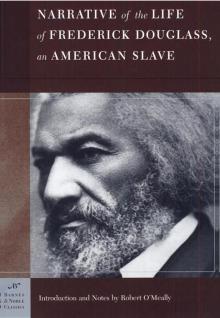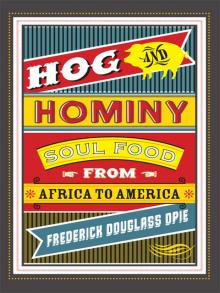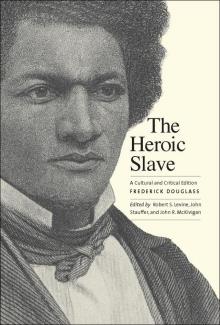- Home
- Frederick Douglass
Hog and Hominy: Soul Food From Africa to America Page 5
Hog and Hominy: Soul Food From Africa to America Read online
Page 5
FIGURE 2.1 “A Representation of the Sugar-Cane and the Art of Making Sugar.” Library of Congress, Prints and Photographs Division, LC-USZ62-7841.
In general, the British viewed white indentured servants as possessing only slightly more importance than the free and enslaved Africans at the bottom of the colonial social order. It was the wealthy white planters, merchants, and professional men of property who wielded the most power and monopolized the best that colonial life had to offer. This, of course, included food. In the seventeenth century, most British planters in Barbados fed enslaved Africans potatoes, a thick gruel they called loblolly, bonavist (kidney beans), and “no bone meat at all; unless an Oxe died: and then they were feasted, as long as that lasted.” The slaves hated their rations and loudly protested until their masters added a regular portion of plantains to their meals.33
In the Caribbean, British planters quickly became the minority to African slaves’ majority. Many planters were so focused on returning to England wealthy that they made little effort to re-create English culture and, instead, in the words of one historian, “accepted the foreign diet as an aspect (and not necessarily an unpleasant one) of doing business in the Caribbean.” He goes on to say, “Wild game, pork, lots of fish and shellfish, as well as many Native American and African foods dominated the exciting and diverse diet of this region.” In general, slaves were allowed to retain and cultivate an African American cooking aesthetic.34
By one estimate, “80 percent of British imports of Gold Coast slaves went to Jamaica, the largest British sugar-producing region in the eighteenth century.” In Jamaica, planters supplied slaves with weekly rations of salted fish and set small parcels of land aside for them to cultivate produce and raise animals, the bulk of the work being performed on Sunday. Slaves in Jamaica managed to raise fowl, pigs, vegetables, and rice.35 What slaves did not use to supplement their rations, they sold on Sunday, the traditional market day and a free day for slaves. With their earnings they purchased salted beef or pork. They then combined the meat received as rations and purchased at market with produce from their gardens to prepare a spicy creolized stew they called oglios, or pepper pot. Charles Leslie, who traveled to Jamaica around 1740, noted, “The negro’s common food is salt meat, or fish boiled with their vegetables, which they season highly with pepper.”36 A lack of utensils and kitchen equipment often necessitated cooking several items together; this may have been the factor that led to the development of the tradition of eating meat and vegetable dishes such as pepper pot and gumbo.37 On Saturday night, hundreds of slaves would meet at balls that often lasted until Monday morning. A travel account from 1790 informs us that the cooks for these events prepared “a number of pots, some of which are good and savory; chiefly their swine, poultry, salt beef, pork, herrings, and vegetables with roasted, barbecued, and fricasseed rats,” which they sold in small quantities out of gourds.38
What is interesting is how enslaved Africans in the West Indies appropriated the tradition of celebrating English holidays like Christmas for their own special occasions. They “greatly plundered” their masters’ supplies of “poultry” for holiday meals. A nineteenth-century diary entry describes how one slave brought a turkey, another brought a pie and pudding or tartlet, and a third brought French preserves.39 Planters also declared New Year’s Day a holiday. The slaves on one plantation arranged an elaborate celebration, including a catered meal consisting of “cold roasted pea-fowls, turkeys, capons, tongues,” and ham.40
Between the seventeenth and eighteenth centuries, European populations in the Americas decreased sizably as the rising economies in sugar production permitted wealthy planters to force poorer Europeans off their Caribbean land. Small, economically dislocated planters began to look for places to relocate. In 1660 Oliver Cromwell’s rule gave way to the Restoration. To reinforce his power, the restored monarch, Charles II, distributed patronage in the form of proprietary colonies in the Americas. Favored members of his court and those who had remained loyal to him during the Cromwell years received this honor. The British proprietors of the Carolinas used the offer of up to 150 acres of free land to attract seasoned settlers. As a result, sizable numbers of small planters from the Caribbean relocated to the new British settlement.41 The majority of the early inhabitants of South Carolina were thus English émigrés who came from Barbados and the Bahamas with their slaves and an “appreciably Creole” mentality.
CULINARY FLEXIBILITY IN THE CAROLINAS
In the relocation, it was vital to slave traders that as many of their human cargo as possible disembark alive, so they took great care to feed enslaved Africans on their slave ships as far as possible with the food most appealing to their specific ethnic groups, despite the deplorable circumstances.42 A passage from the book Remarks on the Slave Trade, and the Slavery of the Negroes, published in London in 1788, describes a dish that cargoes of Africans evidently ate during the long trip from Africa to the Carolinas. “Dab-a-Dab” is described as “a sort of pulp, composed of rice and horse-beans, with yams, boiled and thickend [sic] to a proper consistency” and served with “flabber-sauce” “made of palm oil, mixed with flower [sic] and pepper.”43
Africans came to South Carolina early, both directly from Africa and by way of the West Indies. From the beginning they outnumbered Europeans; one estimate states that in 1715 South Carolina had 6,250 Europeans and 10,500 Africans. In 1749 there were 25,000 European inhabitants and 30,000 Africans. The 1775 figures show a ratio of ten to six: approximately 100,000 Africans to 60,000 Europeans. One chronicler wrote, “The missionaries [in South Carolina], accordingly, were confronted not only by some American-born Africans but also by masses fresh from Africa. The latter were again and again the leaders in revolts.”44 It is safe to say that the Carolinas had a slave population with a vivid memory of West African cultures and culinary habits.
Great numbers of Africans were imported to South Carolina to work the colonies’ large rice plantations. South Carolina slaveholders supported rice cultivation because it proved to be a very profitable cash crop that also provided slaves with a “cheap, filling, nutritious food, for which the supplies could be grown by the slaves on a sustenance basis.” South Carolina, according to one expert, “remained more African than elsewhere in the Colonies.”45 As a result, a creolized African cooking emerged there as slaves of different nations or tribes shared cooking techniques and developed dishes such as gumbo, jambalaya, and hopping John.
As in other parts of the South, gumbo played a vital role in South Carolina’s creolized cooking. With roots in the sub-Saharan communal rice-based dishes, gumbo was a cook’s way of making do with whatever rice, meat, and vegetables that was on hand.46 A similar dish, hopping John consisted of rice, beans, peppers, and salt pork cooked to a stewlike consistency. (We know that, as early as 1742, South Carolinians cultivated Ethiopian or Guinea pepper from an African tree that planter and slave owner Eliza Lucas Pinckney claimed provided a “good Ingredient” in seasoning turtle, which became a southern delicacy.)47 It is probable that hopping John evolved out of rice and bean mixtures such as the Dab-a-Dab served with flabber-sauce that sustained slaves during the Middle Passage.48 The African American tradition of eating refined white rice instead of brown rice dates back to the antebellum period (brown rice is healthier because it contains essential vitamins, minerals, amino acids, and fiber that aid the body in the elimination process).
A detailed account of African American foodways in North Carolina comes from the journal of Scottish-born Jen Schaw. On the eve of the American Revolution (1774–1776), Schaw traveled from Scotland to the West Indies and North Carolina. In Carolina she visited John Rutherford’s four-thousand-acre Hunthill plantation, located ten miles from Rocky Point, North Carolina, and thirty miles from Wilmington. The plantation had about 150 enslaved Africans, many of them artisans employed in various occupations, in the tar, turpentine, and sawmill industries, among others. The plantation comprised fields sowed with corn and other grains, fi
fty head of cattle, hogs, sheep, a sawmill, a smith’s forge for iron work, a timber room, and water enough for two sawmills that produced twenty thouand feet of lumber a week. Schaw writes, “The Negroes are the only people that seem to pay any attention to the various uses that the wild vegetables may be put to.” For example, they made bowls out of calabash, which “serves to hold their victuals.”49 West Africans in Gambia used calabash the same way. One historian tells us that the largest majority of enslaved Africans in South Carolina were “most closely associated with Gambia [followed by Angola].”50
Schaw noted that Rutherford distributed “a quart of Indian corn per day, and a little piece of land which they cultivated much better than their Master.” In addition, slaves on the plantation raised “hogs and poultry, sow calabashes, etc. and are better provided for in every thing than the poorer white people with us.” She goes on to say, “they steal whatever they can come at, and even intercept the cows and milk them. They are indeed the constant plague of their tyrants.”51
The survival of African cookery depended on the region of the Americas where enslaved Africans disembarked. Those who lived and worked in the Caribbean or the Carolinas did so as a black majority with the opportunity and encouragement to grow African food plants and cook African-style dishes such as gumbo, pepper pot, hopping John, and jambalaya. Africans in Virginia lived in a more restricted cultural environment because they were in the minority, making up only 30 to 40 percent of the population.52 Moreover, in the Chesapeake region, masters imposed greater restrictions on the raw food materials to which Africans had access. They had less time and space to cultivate subsistence gardens. In addition, they seemed to receive equally European, African, and Native American food influences. The inhabitants were constantly negotiating the culinary influences of whites, blacks, and Native Americans. In the words of one historian, “Whites in the Chesapeake may have eaten high on the hog while blacks ate low, but they both ate from the same hog.” He goes on to say, “The hog from which blacks and whites ate was fed with Indian corn, a Native American crop. Such were the myriad of connections and influences that allow us to call the Chesapeake Bay region a land of culinary negotiation.”53
HOG AND HOMINY
Southern Foodways in the Nineteenth Century
By the nineteenth century, the invention of the cotton gin and steam-powered cotton textile mills had revolutionized the North American South. In the now-independent United States, cotton emerged as the premier cash crop. By 1811 the cotton gin had expedited the processing of cotton, which led to more cotton being planted, which in turn required more slaves to tend and harvest it. As a result enslaved African labor gradually dominated the South, creating a belt of territory where blacks made up the majority of the population. The industrial revolution and the invention of the steam engine increased travel throughout the new republic. Much of what we know about African American eating traditions in the nineteenth-century black belt comes from people who crisscrossed the region on steamships and trains. The Virginia, Georgia, Alabama, and Carolina regions, though each unique, were united in their cuisines through the use of three main food sources: pork, greens, and cornmeal. Two further habits also connected the different regions: the cooking of poor-quality meats for a long time to break down the connective tissue and the use of salt pork to season fibrous greens, which required extensive cooking to make them tender and easy to digest.
In plantation regions, argues one historian, enslaved Africans “had quietly been making a life for themselves that included a healthy concern with cooking.”1 This endured despite the fact that masters generally distributed stingy allotments of rations. To supplement their meals, slaves in lowland South Carolina worked under the task system, which permitted them larger amounts of time to cultivate gardens and raise domestic animals. We already know that, in South Carolina, planters gave their slaves rice as a part of their food rations. For instance, in the 1850s Frederick Law Olmsted visited several rice plantations in lowland South Carolina. Planters there gave their slaves rice as part of their food rations during the rice harvest and on holidays. Olmsted observed that planters gave “the cracked and inferior rice that would be unmerchantable” to the slaves as rations.2 In addition to rice, enslaved Africans received corn and sweet potatoes, “with the occasional addition of a little meat.” Slaves in Charleston, South Carolina, recalled traveler Adam Hodgson, “prepare for themselves a little supper from the produce of their garden, and fish which they catch in the river.”3
The Swedish novelist Fredrika Bremer had an opportunity to try some slave cooking on a Charleston rice plantation. While roaming near the rice fields one morning she spotted “a number of copper vessels, each covered with a lid, from twenty-five to thirty in number.” The plantation cook had filled each vessel with “steaming food, which smelled very good. Some of them were filled with brown beans, others with maize pancakes,” writes Bremer. “I waited till [the slaves] came up, and then asked permission to taste their food, and I must confess that I have seldom tasted better or more savory viands.” As the slaves came from the fields, each one sat down and ate, “some with spoons, others with splinters of wood. . . and each contained an abundant portion.”4 African Americans adapted pancakes from the Dutch. The Dutch traditionally made them from wheat flour, while southern African Americans used cornmeal to make hoecakes.
In the 1850s, Olmsted observed slave cooks in action on a large tobacco plantation further north, in Petersburg, Virginia. After an eleven-hour workday, slaves on the Gillin plantation returned to their quarters, where they cooked their own suppers. This tended to be “a bit of bacon fried, often with eggs, corn-bread baked in the spider [a frying pan with legs or feet on the hearth] after the bacon, to absorb the fat, and perhaps some sweet potatoes roasted in the ashes.”5
In the nineteenth century, African-American cooks continued to grow and cook with yams and sweet potatoes. They used these staples like bread, just as their descendents had done in West Africa.6 By the mid-nineteenth century, slaves in Virginia had influenced their masters to eat the tubers the same way. By the eve of the Civil War, African American cooks in South Carolina and Virginia had retained many African eating traditions and created new ones. Whites who lived and worked in close proximity to enslaved African Americans typically ate these same cheap, delicious, and filling dishes.7 From the British African Americans acquired a taste for and the ability to make pies and puddings, which they made with both the African yam and the American sweet potato.8 They also took pie making to another level with the baking of fruit cobblers from cast-off and foraged fruit and scraps of dough leftover from pie making done in the big-house kitchen.
SPECIAL OCCASIONS DURING SLAVERY
As slaves, African Americans only gorged on large amounts of meat and splurged on rich desserts on a few holidays and religious days during the year. For African Americans, then, good eating became associated with harvest feasts, Christmas, New Year’s, the Fourth of July, religious revivals, and Sundays (their only day off during the week). On these special days, slaves received time to cook and garden, extra rations, and access to sweets. Most enslaved African Americans ate much smaller portions and very little meat during the week and did hard physical labor from dawn until dusk six days out of seven in extremely hot weather. Obesity thus was not the problem it is among African Americans today. The correlation between food traditions and religious events dating back to the antebellum period explains why spirituality is also associated with making soul food.
Like their West African ancestors, enslaved African Americans made special foods a part of their religious activities. The function of food at religious assemblies represents an important continuity between West African and African American religions. In the Americas, enslaved Africans continued to use sacred foods such as chicken as they adapted to the rudiments of New World Christianity in the South. African and southern American religious events, with their singing and abundance of food, played an important role in shaping Afric
an American religious tradition and the development of soul ideology.
Africans learned Christian theology not only from the preachers that masters hired but also from enslaved licensed and unlicensed preachers and exhorters. Peter Randolph, a slave in Prince George County, Virginia, recalled that, “Not being allowed to hold meetings on the plantation,” unauthorized African American preachers would assemble “slaves in the swamps, out of reach of the patrols. They had an understanding among themselves as to the time and place of getting together.”9 Although the core of the enslaved Africans’ religious activity took place in private in the slave quarters, praying grounds, and hush harbors (a place where slaves secretly met to practice their religion), public gatherings such as Sunday church services and revivals were also very important.10
It was not uncommon for masters to give their slaves permission and support to attend organized religious meetings such as Sunday church services and revivals. Annual revival meetings, which the Baptists called “protracted meetings” and the Methodists called “camp meetings,” were morally sanctioned religious events that provided opportunities for all southerners to socialize, gather news, worship the Lord, evangelize, and feast. Church picnics and all-day preaching and dinner on the grounds became traditions basic to southern churchgoers, as most African Americans were by the mid-nineteenth century.11 “By the eve of the Civil War,” writes a preeminent historian of African American religious traditions, “Christianity had pervaded the slave community.” He adds: “The vast majority of slaves were American-born, and the cultural and linguistic barriers which had impeded the evangelization of earlier generations of African-born slaves were generally no longer a problem. The widespread opposition of the planters to the catechizing of slaves had been largely dissipated by the efforts of the churches and missionaries of the South. Not all slaves were Christian, nor were all those who accepted Christianity members of a church, but the doctrines, symbols, and vision of life preached by Christianity were familiar to most.”12

 Narrative of the Life of Frederick Douglass: An American Slave
Narrative of the Life of Frederick Douglass: An American Slave My Bondage and My Freedom
My Bondage and My Freedom Two Slave Rebellions at Sea
Two Slave Rebellions at Sea The Color Line in America
The Color Line in America The Negro Exodus from the Gulf States
The Negro Exodus from the Gulf States Hog and Hominy: Soul Food From Africa to America
Hog and Hominy: Soul Food From Africa to America Narrative of the Life of Frederick Douglass
Narrative of the Life of Frederick Douglass![An Appeal to Congress for Impartial Suffrage [a machine-readable transcription] Read online](http://i1.bookreadfree.com/i/03/23/an_appeal_to_congress_for_impartial_suffrage_a_machine-readable_transcription_preview.jpg) An Appeal to Congress for Impartial Suffrage [a machine-readable transcription]
An Appeal to Congress for Impartial Suffrage [a machine-readable transcription] The Color Line
The Color Line My Bondage and My Freedom (Penguin Classics)
My Bondage and My Freedom (Penguin Classics) The Heroic Slave
The Heroic Slave